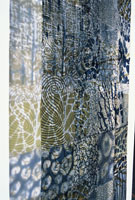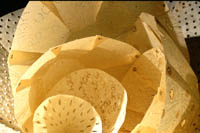|

Human/Nature
2004
96” x 42” x 6”
Xerographic transparencies, eyelets, Plexi wall support
$3,300

Human/Nature (detail)
2004
96” x 42” x 6”
Xerographic transparencies, eyelets, Plexi wall support
$3,300

PERCOLATORS (a la Chihuly), detail
|
BIOGRAPHICAL
INFORMATION
| |
|
|
1985 |
MFA (Textile
Arts) John F. Kennedy University/Fiberworks Center for the Textile
Arts, Berkeley, CA
|
|
Richard Elliott has taught a variety of surface design, hand-constructed
textiles, fiber art and structural sculpture courses at the California
College of Arts and Craft, Oakland, CA; University of California
at Davis; College of Marin, Kentfield, CA; The School of the Art
Institute of Chicago, where he was Visiting Artist in the Fiber
Department from 1993-1996; Columbia College, Chicago, IL; the Textile
Arts Centre, Chicago, IL, and the California State Summer School
for the Arts.
He served as a California Arts Council Artist-in-Residence at
Creative Growth Art Center for developmentally challenged adults
in Oakland, CA, from 1989-1992, and has been a guest artist, lecturer
and juror at several colleges and art centers in the Bay Area,
Illinois and Colorado. His mixed media work has been exhibited
nationwide in galleries and alternative spaces, such as Alcatraz
Island Prison, and has appeared in such publications as the San
Francisco Chronicle, Artweek, Fiberarts and American Craft magazines.
|
ARTIST STATEMENT
Stemming from
my background and teaching career in textile arts, my work employs simple,
sometimes crudely rendered images, patterns and textures as surface imagery
on three-dimensional container forms, as well as two-dimensional wall
pieces made of layered, translucent tracing paper.
While several pieces incorporate a sense of humor or pay homage, with
satirical flattery, to other contemporary artists, other series focus
on rather mundane, overlooked patterns and the context of their references.
Patterns of human identification, such as fingerprints, chromosomes, DNA
and teeth may be combined with microscopic cellular and fiber structures,
heart monitor graphs, and even bar codes in works commenting on the socio-politicized
body/vessel and the human condition. These images, along with patterns
found inside "security" envelopes or on fabrics, form the basis
of my visual vocabulary for investigating and communicating sophisticated
networks and systems, common to us all.
Photocopies of photographs, drawings, materials and computer-generated
images are altered, layered and visually "softened" through
xerographic transfer processes applied to paper. The paper itself is also
treated as a "fabric" through a layering process which creates
a parchment or skin-like material with a textured surface and a haptic
quality appealing to our sense of touch.
It can take many years before one realizes some very basic, innate premise
for the reason that particular images or shapes hold one's interest and
appear over and over again (sometimes disguised) in one's work. It has
taken most of my life to embrace the simple revelation that I have always
been enthralled by the patterns and textures I happen upon in my daily
life and research. The pattern of cracks in asphalt, tree bark, leaf skeletons,
spots on a seashell, the network of loops in a crocheted shawl or the
interlacement of a basket, wrinkles in skin or clusters of microscopic
blood cells are some of the visual stimuli that continue to engage me
and further expand my image library.
Linear structures and groupings of shapes inform and construct our environment,
the ways we move through it and the ways we operate to organize time,
materials and information by hand or with a computer. We plan, graph,
measure, mark, count, build, schedule, record, read, write, fabricate,
all based on repeated linear pattern variations or similar systems. However,
we take for granted our intricate, interconnected bodily systems of vessels,
cells and fluids enabling our lungs to breathe, our hearts to beat, our
blood to flow and our organs to perform their multi-layered, magnificent
functions. It is the rhythmic beauty of some of these systemic patterns
that I wish for others to notice.
|


